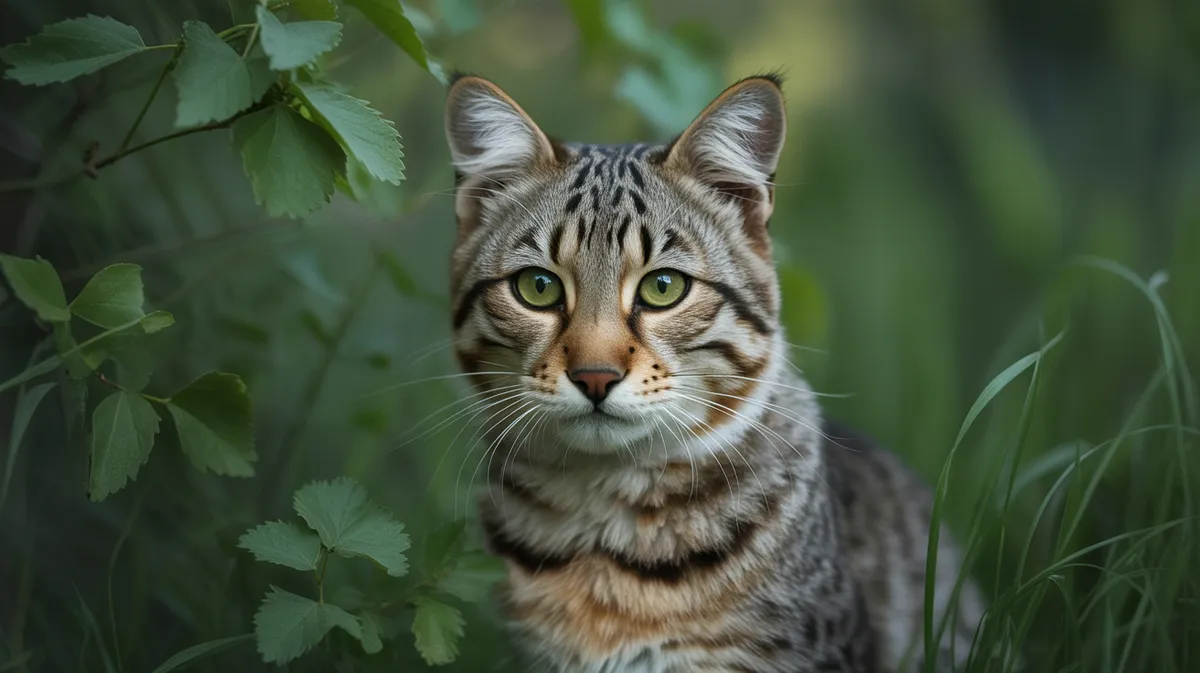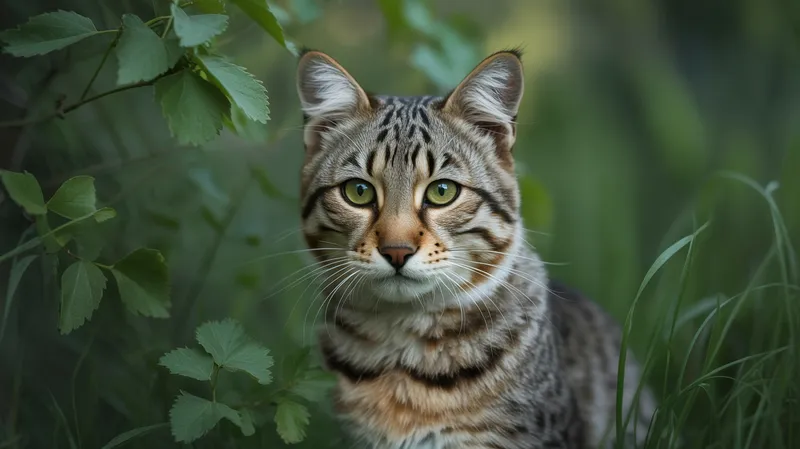
Ukrainian Levkoy
Felis catus

Meet the Ukrainian Levkoy
The Ukrainian Levkoy is a rare and distinctive cat breed developed in Ukraine in the early 2000s. It is known for its unique appearance, featuring inward-folding ears and a mostly hairless, soft, and wrinkled body. The breed is a result of crossbreeding between hairless Donskoy cats and Scottish Folds, giving it its signature look. Ukrainian Levkoys are social, intelligent, and affectionate, often forming strong bonds with their human companions. Their unusual appearance and friendly temperament make them particularly popular among cat enthusiasts seeking an unconventional pet.
Classification
Mammal
Habitat
Domesticated
Diet
Carnivore
Lifespan
9-15 years
Conservation
Not Evaluated
Weight
3.5-6.5 kg
📖Fascinating Facts
Folded Ears
The Ukrainian Levkoy's most distinctive feature is its inward-folded ears, inherited from the Scottish Fold.
Hairless Body
Their mostly hairless and soft, wrinkled skin is a result of breeding with the Donskoy cat.
Ukrainian Origin
This breed was first developed in Ukraine in the early 21st century by breeder Elena Birjukova.
📋Detailed Description
The Ukrainian Levkoy is a medium-sized, hairless domestic cat breed notable for its distinctive inward-folding ears, a trait inherited from the Scottish Fold lineage, and its soft, elastic, and often wrinkled skin, a result of Donskoy ancestry. Adult Levkoys typically weigh between 3.5 and 6 kilograms (7.7–13.2 lbs), with males being slightly larger than females. Their bodies are long and slender yet muscular, with a flexible spine and elongated limbs that give them a graceful, panther-like gait. The head is angular with a flat forehead, prominent cheekbones, and a slightly sloped profile. The breed's skin is mostly hairless but may display fine down, particularly on the muzzle, tail, and feet, and is often described as warm and suede-like to the touch. Wrinkling is most pronounced around the head, neck, and limbs, especially in kittens and young adults. Ukrainian Levkoys are highly social and intelligent, exhibiting strong attachment to their human families and displaying playful, inquisitive behaviors well into adulthood. They are known for their gentle vocalizations and expressive body language, often using their paws to interact with objects and people. The breed's unique appearance and affectionate temperament have contributed to its growing popularity among enthusiasts, despite its limited recognition outside Eastern Europe.
💡 Did you know?
Despite their exotic looks, Ukrainian Levkoys are known to get along very well with other pets and children, making them excellent family companions.
🔬Research & Sources
Wikipedia Summary
The Ukrainian Levkoy is a cat breed with inward-folding ears and little to no hair. The cats are of medium size with a longish body, appearing both muscular and slender. They have soft, elastic skin; an excess of which leads to a wrinkled appearance. The breed is not recognized by any major, international cat fancier and breeder organizations, only Ukrainian and Russian clubs.
Last Modified: 5/26/2025
🎭Behavior & Social Structure
Ukrainian Levkoys are exceptionally social and thrive on human interaction, often following their owners from room to room and seeking physical contact. They are playful and curious, engaging in interactive games and exploring their environment with enthusiasm. Unlike some other breeds, Levkoys are generally tolerant of other pets, including dogs and other cats, and often form close social bonds with them. Their intelligence is reflected in their ability to learn tricks, respond to their names, and even solve simple puzzles. Due to their lack of fur, they tend to seek out warm places, frequently curling up in sunbeams or on heated surfaces. Levkoys are not known for aggressive hunting behavior but retain the typical feline instinct to stalk and pounce on toys or small moving objects. Their daily routines include periods of active play interspersed with long naps, often in close proximity to their human companions.
👶Reproduction & Life Cycle
The Ukrainian Levkoy reaches sexual maturity between 8 and 12 months of age. Breeding is typically managed by experienced breeders to maintain genetic health, as both the hairless and folded-ear traits are associated with specific genetic considerations. The gestation period averages 63–65 days, after which litters of 2–5 kittens are born. Kittens are born hairless or with a fine down and with straight ears; the characteristic ear fold develops within the first few weeks. Parental care is primarily provided by the mother, who nurses and grooms the kittens until weaning at around 8–10 weeks. Responsible breeding practices avoid pairing two folded-ear cats to reduce the risk of cartilage-related health issues. There is no strict breeding season for domestic cats, but most litters are planned to coincide with warmer months to reduce risks associated with hypothermia in hairless kittens.
🛡️Adaptations & Survival
The Ukrainian Levkoy's most striking physical adaptations are its hairlessness and folded ears. The lack of fur is the result of a dominant gene from the Donskoy breed, which reduces insulation but also minimizes shedding and allergen production. The inward-folding ears, inherited from the Scottish Fold, are due to a cartilage mutation. Their wrinkled, elastic skin provides flexibility and may aid in thermoregulation, though it also requires regular cleaning to prevent skin infections. Behaviorally, Levkoys compensate for heat loss by seeking warmth and displaying a preference for cuddling. Their social and intelligent nature is an adaptation to domestic life, enhancing their ability to bond with humans and thrive in indoor environments.
📚Research Sources
🎨Cultural Significance
The Ukrainian Levkoy is a modern symbol of Ukrainian innovation in cat breeding, reflecting both national pride and the region's unique approach to feline aesthetics. While it does not have deep roots in folklore or traditional symbolism, the breed has become a point of interest in Eastern European cat shows and is celebrated for its unusual appearance and affectionate temperament. Its distinctive look has made it a subject of social media attention and a conversation piece among cat enthusiasts. There are no known traditional uses or mythological associations.
🔬Recent Research & Discoveries
Recent research on the Ukrainian Levkoy has focused on the genetic implications of combining the hairless Donskoy and folded-ear Scottish Fold traits. Studies have highlighted the importance of avoiding homozygosity for the fold gene to prevent skeletal disorders. Ongoing research in veterinary genetics is examining the long-term health outcomes of hairless breeds, including skin barrier function, susceptibility to dermatological conditions, and the impact of reduced fur on thermoregulation. There is also interest in the breed as a model for studying cartilage development and congenital skin disorders. Due to its rarity, most research is conducted by breeders and regional veterinary specialists rather than large academic institutions.
🎥Wildlife Videos

15 Horrifying Animals That We Have Bred Into Existence
15 Horrifying Animals That We Have Bred Into Existence. In this video we go over 15 Horrifying Animals That We Have Bred Into ...
The Squeezed Lemon

TOP 10 Most EXPENSIVE CATS In The World | 1 Minute Animals
Top 10 Most Expensive Cat Breeds In The World | 1 Minute Animals *SUBSCRIBE HERE* : https://bit.ly/3vRV2vO ...
1 Minute Animals

Couple Spots Exotic Animal At The Zoo And Decides They Must Have It
For copyright matters please contact us at: noxikmoha@gmail.com.
Did You Know Animals ?

These Fine Felines Take the Crown
Discover the world's 10 most expensive cat breeds! From their stunning looks to unique traits, find out what makes these feline ...
The Crown Picks

Top 10 Most Expensive Cat Breeds You Won't Believe Exist!
Top 10
🌍Habitat Information
The Ukrainian Levkoy typically inhabits Domesticated environments. Ukrainian Levkoys have adapted to their environments with specialized features and behaviors.
Primary Habitat:
Domesticated
More detailed habitat information will be available soon.
🛡️Conservation Status
The Ukrainian Levkoy is currently classified as Not Evaluated. Conservation efforts are crucial for preserving this species for future generations.
Common Threats:
- 🏠Habitat loss and fragmentation
- 🌡️Climate change impacts
- 🎯Hunting and poaching
- 🏭Human-wildlife conflict
⚠️Threats & Conservation Challenges
As a domesticated breed, the Ukrainian Levkoy does not face natural predators or habitat loss, but it is subject to several health and welfare concerns. The gene responsible for folded ears can cause cartilage and bone abnormalities, leading to osteochondrodysplasia if not carefully managed in breeding. Hairlessness increases susceptibility to temperature extremes, sunburn, and skin infections. The breed's rarity and lack of recognition by major international cat registries limit its genetic pool, increasing the risk of inherited disorders. Ethical breeding practices and owner education are critical to the breed's long-term health and welfare. There are no current population estimates, but the breed remains rare outside Ukraine and Russia.
🔬Scientific Classification
Scientific Name
Felis catus
Classification Hierarchy
🔍 About Taxonomic Classification
Taxonomic classification is a hierarchical system used by scientists to classify and organize living organisms based on shared characteristics and evolutionary relationships.
The system moves from broad categories (Kingdom) to increasingly specific ones, with each animal's scientific name typically consisting of its Genus and species.
📝Community Notes
Share your observations and insights about the Ukrainian Levkoy with our community of wildlife enthusiasts.
Join Our Community
Sign in to share your observations and connect with fellow wildlife enthusiasts.
Sign In to ContributeNo community notes yet
Be the first to share your observations about the Ukrainian Levkoy!
Explore Ukrainian Levkoy
Select a tab above to learn more about this amazing animal.
📸Photo Gallery
No photos available for this animal yet.
🌟Discover More Wildlife
Continue your journey of discovery with more fascinating animals from our database
